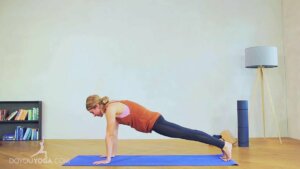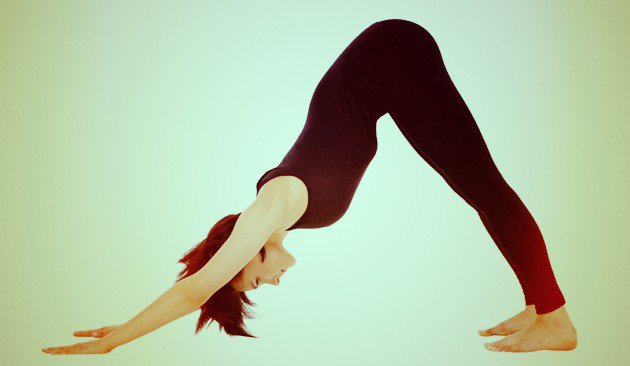I’ve been in yoga trainings and workshops where the lead teacher typically avoids using the word “mistakes” to describe a student’s alignment in a pose.
Partly, it’s because there is no single right way to do something; each body is unique, and there can be so many interpretations of the same pose that one person’s Downward-Facing Dog Pose (Adho Mukha Svanasana) could look very different from their yogi neighbor’s.
I agree with that logic as well, as it allows for each individual to find the yoga pose that authentically resonates with their bodies and unique needs, without feeling limited to one definition. So when I encounter a pose that could use a little more fine-tuning, I use the word misalignment.
If you’re looking to fine-tune different postures within your practice, I highly recommend this free 30 Day Yoga Challenge. You’ll be guided through the poses, so you’ll be able to correct any alignments issues you have.
Why Alignment Matters
In yoga, it’s not about whether the pose looks like a photo out of Yoga Journal, but how the pose feels for the student.
When there is a misalignment, it gets in the way of the comfortable, continuous flow of energy in the body, and the student will find it hard to maintain what in the Yoga Sutras is called Sthira Sukham Asanam or steady (sthira), comfortable (sukham) pose (asanam).
Without a sense of ease in the pose, it’s hard to imagine coming back to your mat for more.
Down-Dog Misalignments
As one of the more well-known yoga poses, Downward-Facing Dog might seem to be an easy (dare I say boring?) pose. Which might be a reason practitioners slip into so many misalignments with this pose; they take it for granted.
However, if we work to achieve the pose with conscious alignment, Downward-Facing Dog will become a place where you can continually discover something more.
It’s a challenge to list all of the misalignments in a pose, because the number can be as infinite as the growing world population. So to make it digestible for now, I’ll focus on some common culprits that I see when students first come to my classes.
These can show up as isolated incidents, but they usually come together like a group of uninvited guests to your party. Have a look at these Downward-Facing Dog Tips that will help you avoid the most common misalignments!
Misalignment 1: Dancing Hands and Feet
Hands and feet are not centered or firmly rooted to the floor, which can stress the wrists (see my column on wrist pain when hand placement goes wrong) or ankles. Also the space between the hands and feet is either too close (like a forward bend) or too far apart (like a hammock).
Solution
 Start with Plank Pose.
Start with Plank Pose.Start with the Plank to Downward-Facing Dog check.
In Downward-Facing Dog, your hands and feet are roughly the same distance they would be in Plank. In Plank, line up shoulders over wrists; you can also line up the inner shoulders (where arm meets torso) with your index finger or middle finger, whichever is more comfortable.
Your shoulders, hips, and knees are in one inclined line. Without moving your hands and feet, shift your hips back and up for Downward-Facing Dog. Spread your fingers and toes wide; take up as much real estate as you comfortably can with your hands and feet.
For the feet, press down evenly on the top two corners of the foot, the big toe and pinky toe mounds.
There are different schools of thought on whether your feet are hip-width apart or pressed against each other, but the main alignment point to remember is that you shouldn’t be able to see your ankles when you look between the legs.
Misalignment 2: Disconnected Arms and Shoulders
Often, when beginners first put their hands and feet on the floor, it looks pretty awkward. Unlike our four-legged friends who are used to coordinating with all four legs, humans have a harder time remembering to unite the four limbs.
In Downward-Facing Dog, shoulders can press up against the ears, or the elbows poke out to the sides as though they are bracing themselves from falling.
Solution
Cultivate space in the chest and shoulders by plugging the arm bones into the shoulder sockets and draw the shoulder blades down the back toward the hips. Firm the muscles of the arms without hyperextending the elbows, and externally rotate the arms.
It feels as though you’re trying to point your thumbs forward, but your hands should not move. With these movements, you’ll feel the triceps wrap around the bone and the elbows will hug toward each other to help straighten the arms.
Lastly, firm the thighs to shift the weight off the arms and give you the sense of your spine growing longer. You can also practice these movements with a yoga strap looped above the elbows and a yoga block between the legs.
Misalignment 3: Rounded or Arched Back
In a rounded back, rather than an inverted V, the back is curved upwards and the spine is shortened.
This misalignment could be a symptom of tight hip flexors, hamstrings, shoulders, or specific spinal conditions like scoliosis or kyphosis, an excessive rounding of the spine. The opposite scenario occurs for hyper-flexible folks where there is an excessive arch in the spine.
Solution

For the tight folks, patience and dedication is key. You can bend the knees to shift more weight towards the legs and help traction and elongate the spine. Shrug the shoulders back to create more space around the collar bones and in the shoulders.
You may need to practice this version of the pose for a long time until your body starts to loosen up more to work towards straightening the legs while maintaining a long spine.
For the super flexible students, cultivate more strength here. Resist the urge to let your chest hang through the arms; instead draw the lower ribs into the body and lift your head between the arms, so the ears are parallel to the upper arms and the collar bones are wide.
Misalignment 4: High-Heeled Dog
The heels are high off the ground, which could indicate tight hamstrings, hip flexors, or calf muscles. This also likely means much of the body weight rests on the wrists.
Solution
Much like with the rounded back scenario, bending the knees to lengthen the spine can be a great help here. While keeping the feet pointing forward, internally rotate the legs, like you’re squeezing a block, and firm up the quadriceps as though someone were pulling you back by your hips.
Once the body warms up, the muscles might loosen up enough to move the heels closer to the floor, but don’t push it. Wait for your body to agree to deepen. The aim is not to just get the heels to the floor, but to work towards doing so with ease and with the whole body working together.
Try some of these Downward-Facing Dog tips out! Remember to practice happy, and comment below if you have any questions!


